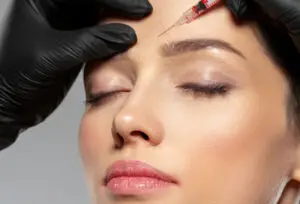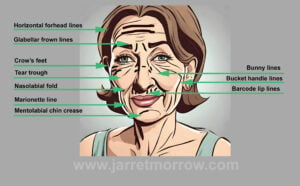You may wonder exactly how cosmetic professionals assess facial beauty and profiles. If you have ever gone for lip filler injections, in particular, you may have seen your injector looking at your face from the side view and use a device such as ruler to create a line from the tip of your nose to the tip of your chin.
Ricketts’ E-line or aesthetic plane is one of several lines used to evaluate and assess facial profiles.
Doctors use measurements of structures relative to this line to assess features of attractiveness and help plan procedures such as cosmetic injectables.
What is meant by Ricketts’ E-line?
The Ricketts’ E-line is an imaginary line drawn straight down starting at the tip of the nose (called the pronasale), and extending to the tip of the chin (called the pogonion).
The ”E” in E-line stands for esthetic. The idea is you can find out how attractive a person’s face is by measuring the distance of a specific anatomical structure from this line.
It can help to identified facial features such as a receding chin or guide doctors doing lip injections for ideal projection.
How is Ricketts’ E-line used in cosmetic procedures?
Ricketts’ E-line serves as a crucial tool for cosmetic doctors when performing procedures like lip fillers and injections. Here’s how it’s used:
- Assessment: Cosmetic doctors first assess the patient’s facial features in relation to Ricketts’ E-line. They measure how much the nose, lips, and chin project beyond or fall below this line.
- Treatment Planning: Based on these measurements, doctors can determine how much enhancement or correction is needed. For example, if the lips fall short of the ideal position below the E-line, they may recommend lip fillers to achieve the desired fullness.
- Customized Treatments: The E-line measurements allow doctors to provide personalized recommendations. They can decide on the type and amount of fillers to use, ensuring a natural and harmonious result that aligns with the patient’s unique facial proportions.
- Outcome Evaluation: After the injections, doctors can re-evaluate the patient’s facial features in relation to the E-line. This helps ensure that the desired outcome is achieved, and adjustments can be made if necessary.

What are the ideal values when using Ricketts’ E-line?
You may be curious what exactly is meant by “ideal” values. By “ideal” is meant most attractive.
Cosmetic doctors are most interested in the distance of the nose, lips, and chin below Ricketts’ E-line. There are ideal values for the distances of these specific facial structures from the line.
It is important to remember that Ricketts’ E-line is a theoretical ideal that does vary among populations. This is because ethnicity and culture impact what a person may consider to be attractive.
An example is when looking at lip position –
for Caucasian people the preferred ideal is that the upper lip be 4 mm and lower lip be 2 mm below the line. In Saudi populations, the preferred upper lip position is at 3 mm and lower lip at 1 mm below the line.2
Use in cosmetic procedures?
Initially the E-line was for use in orthodontics. Today the line is also used for other cosmetic procedures routinely performed on the face.
Cosmetic procedures on the lower features of the face can benefit from a surgeon using Ricketts’ E-line to make measurements. This line is an excellent way to assess how much the nose, lips and chin protrude outwards.
Measurements can help to determine how much a person’s lower facial features deviate from values considered as ideal and aesthetically most attractive. This is useful when your doctor is assessing your features and planning what can be done.
The E-line measurements can indicate how much cosmetic work is needed to achieve a particular look. It can give insight into what type of procedures will work best. For example, using the E-line can answer questions such as should a person get lip fillers or have work done on their chin?
In some cases, a nose may project too much or not enough. Similarly, a chin may stick out too much or be too far below the E-line value, or maybe the lips do not project enough. The point is the E-line is a helpful tool for cosmetic surgeons.
What is the significance of the Ricketts’ E-line for lip procedures?
The E-line is one measure that can show how much the lips naturally protrude from the face before any type of lip treatment begins.
There are gender differences with respect to the lips. Researchers, using Ricketts’ E-line found that the lips of females usually protrude more than those of males. Here’s more info about ideal lip ratios for women.
Facial proportions are important and comparing what a person’s lips look like compared with the nose and chin, is useful in planning specific work on the lips. Cosmetic doctors use measurements like the E-line to assess a patient’s lips before starting work.
Injection methods are often used to enhance the lips. This is when substances such as hyaluronic acid, are injected into the lips as fillers. This helps make lips fuller and more beautiful.
Ricketts’s E-line can indicate how much deviation from normal occurs with the lips and other facial features in patients who are born with cleft palate and cleft lip.5
Such birth defects can lead to asymmetry in the lower jaw and also can result in health complications. The E-line is useful for surgeons planning corrective surgery for patients with these birth defects.
To sum up: Ricketts’ E-line is a useful guide for assessing facial beauty and planning potential treatment options. It can also be used when correcting birth defects.
Who was Dr Robert Ricketts?
Dr. Robert M. Ricketts was an American orthodontist who introduced the concept of evaluating facial features like the lips, nose, and mouth in relation to a straight line drawn from the nose to the chin tip.
Dr. Ricketts understood the importance of considering facial proportions in orthodontic treatments. He realized that procedures like tooth extractions and braces could alter the proportions of the jaw and lower face.
To better plan and assess these procedures, Dr. Ricketts proposed using measurements like the E-line before and after treatment. This allowed orthodontists to track changes in facial features and ensure optimal results.
How is the E-line used in orthodontics?
The E-line has been used in orthodontics. Most people probably know that orthodontics involves fixing teeth misalignment.
In the past, measurements and proportions of the teeth and jaws were based on bone and hard tissue structures. Orthodontists then realized that this is inadequate and that soft tissues also need to be taken into account.
Some of the soft tissues in the area of the E-line will change as a result of orthodontic changes over time. This is complicated in orthodontics since it usually involves children who are also growing, so proportions are also changing due to development.
The soft tissues, the muscles, and connective tissues of the jaw and lips, all need to be taken into account in orthodontic procedures3. This is where using the E-line becomes important.
The E-line can show how the jaw changes after the extraction of teeth. Ricketts’ E-line can show lip movement after orthodontic treatment3. Dental extractions can have a big impact on the lips. The E-line can indicate a posterior movement of the lips after teeth extraction, but the accuracy of the values is complicated by growth changes.4
References
- Ricketts, R. M. (1968). Esthetics, environment, and the law of lip relation. American journal of orthodontics, 54(4), 272-289.
- Bandar Al Abdulwahhab, B. D. S., & Pani, S. C. (2013). Assessment of lip position preferences in a Saudi population using computer imaging. Eur J Esthet Dent, 8, 444-452.
- Qutub Khan, S. H. A. K. E. E. L., Ashraf, B., Ghulam Abbas, I. R. T. I. Z. A., & Mahmood, S. (2015). Soft tissue analysis of aesthetically pleasing faces. Pakistan Oral & Dental Journal, 35(3).
- Buschang, P. H., Fretty, K., & Campbell, P. M. (2011). Can commonly used profile planes be used to evaluate changes in lower lip position? The Angle Orthodontist, 81(4), 557-563.
- Tindlund, R. S., & Rygh, P. (1993). Soft-tissue profile changes during widening and protraction of the maxilla in patients with cleft lip and palate compared with normal growth and development. The Cleft palate-craniofacial journal, 30(5), 454-468.






